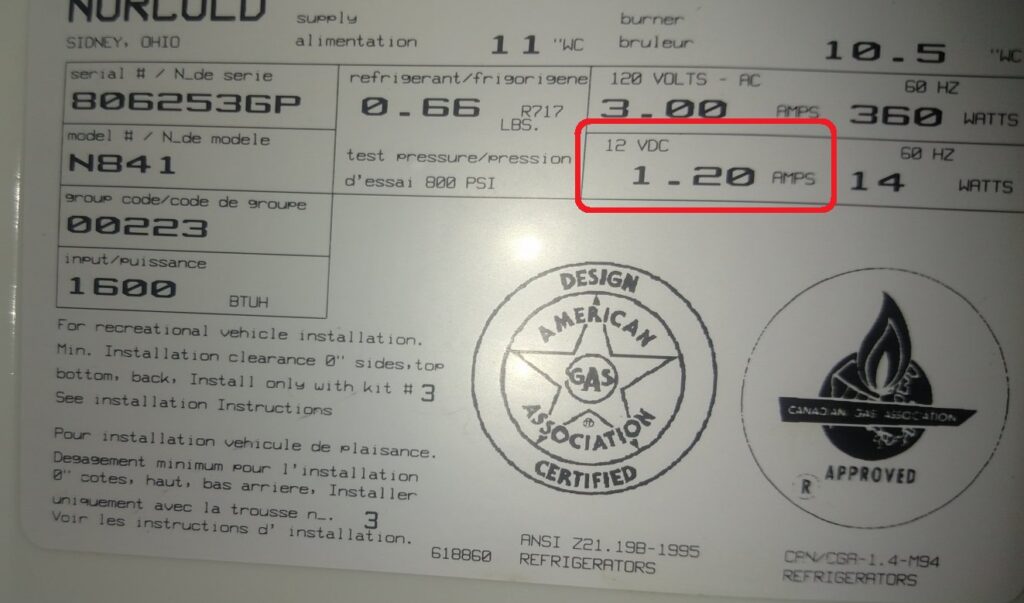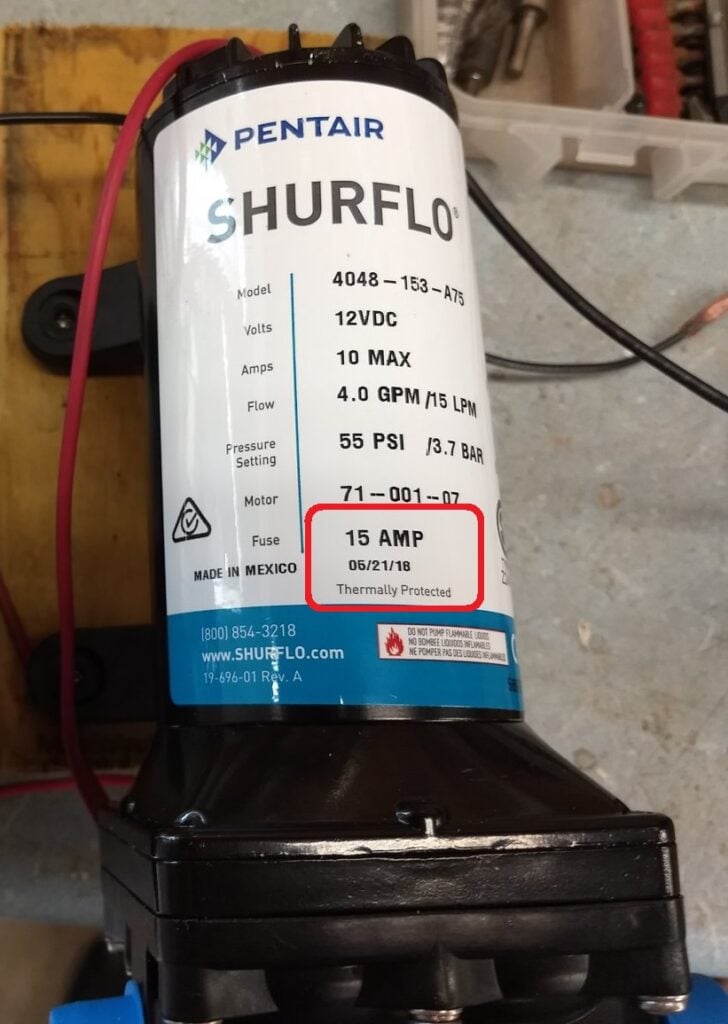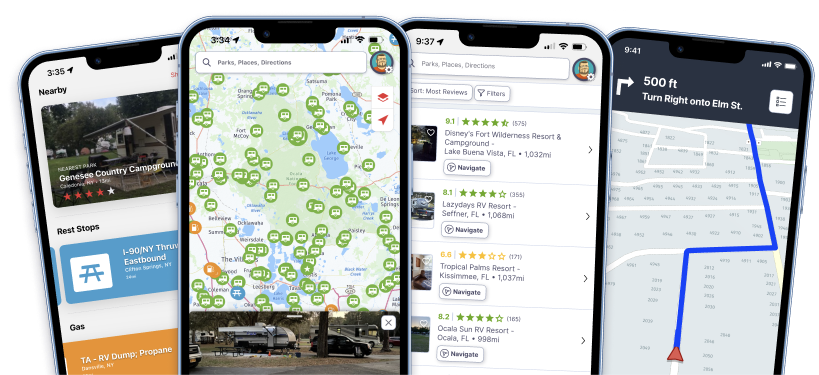Note: As in the last two installments, this information is designed to help newbie RVers better understand the electrical needs of their RV. As with anything electrical, there are exceptions to every rule of thumb, but the basic information shared below is applicable in most RVing situations. Results will vary depending on temperature, battery condition, large loads, and loads over long periods of time.
In our previous article, we looked at how to calculate your RV’s 120-volt shore power needs by calculating watts and watt-hours. In this post, we will look at how to determine the electrical demands of your 12-volt battery system by learning about amps and amp-hours.
As we shared in the last couple of installments, the electrical needs of 120-volt appliances are typically expressed in “watts” on the back of the appliance. When they aren’t expressed as watts, we looked at how to multiply voltage times amperage to determine watts, then by including run times to determine watt-hours.

Norcold 12-volt needs – Photo from iRV2
While watts and watt-hours can also be applied to the 12-volt system in RVs, it seldom is. Rarely are the electrical requirements of the 12-volt appliances (water pump, furnace motor, lights, etc) expressed in any form other than amps.
This is definitely more convenient than watts as deep-cycle RV batteries (aka “House Battery”) are rated in amp-hours rather than watt-hours. Note that amp-hours are commonly abbreviated as “A.H.”, “Ah” or similar.
Just as we added up the 120-volt shore power needs in watt-hours, we will add up the needs of 12-volt (battery-powered) appliances in amp-hours.
Examples:
- An incandescent 12-volt ceiling light bulb has a draw of 1.5 amps. If you leave the light on (burning) for one hour it will consume 1.5 amp hours of battery power. If you burn it for 2 hours it will consume 3 amp hours of battery power, etc.
- The blower motor and related 12-volt components of your propane furnace draw 7 amps while running. If the furnace runs a half-hour, it will consume 3.5 amp hours from your battery bank. 7 amps X .5 hours = 3.5 amp hours
- An LPG leak detector that draws .2 amps and operates 24 hours will consume 4.8 amp hours from your batteries.

Water pump requirements – Photo from iRV2
Now, if you are connected to 120-volt shore power, none of the above matters much, as your converter charger will replenish the RV batteries as loads (amps) are drawn. Where it becomes important is when you are dry camping (no shore power) and the reserve power (amp-hours) in your RV batteries is all you have to supply your electrical needs.
A typical deep-cycle RV battery will be rated around 80 amp-hours, which in theory would supply one amp for 80 hours. However, in reality, if you discharge a lead-acid battery (what you likely have in your RV) more than 50% of the rated capacity you will greatly shorten the life span of the battery. Therefore, when calculating the reserve amp-hours of your RV’s batteries, the usable power will be 50% of the rated capacity.
Now, it is just a matter of adding up your amp hours for every 12-volt item in your RV (like we did for watt-hours in the last installment) and divide that number into the amp-hours available in your RV’s battery bank to determine approximately how long the battery will last.
Now that you know how long your batteries are likely to last, you can plan accordingly for your next dry camping adventure in RVing!
See our previous installments here:

Dave,
When you have two batteries say 1- 80ah and 1-70ah would that mean a total of 150 ah and half of that is usable (75ah) before being hard on the batteries? Or does it effect the first/last battery differently than the other one?
Thanks for all the help you’ve offered along the way!!!
It is not a good idea to have dissimilar battery pairs eg 80 amp/hr and 70 amp/hr You will only have 140 amp/hrs as the higher amp/hr battery only charges to the lower
Good information for beginners.
Hersh,
For starters if the batteries are wired together in parallel ALWAYS use like batteries. Now to answer you question – yes you would have 150 total amp hours capacity, but only 75 amp hours usable (50% of rated capacity). If the batteries are alike and wired together parallel correctly they would draw down evenly under load. If you must use dislike batteries you should keep them isolated and draw them down separately.
Dave, Oops! Just backwards.
To determine useful time divide battery Ah capacity (actually 1/2 battery capacity) by Ah usage. If usage is 20 Ah per day and battery capacity is 80 Ah you can go two days without significant battery damage. That is, 40 Ah capacity (1/2 rated battery capacity) divided by 20 Ah per day.
Thanks Dave!
Wilyoung, Thanks for the comment – I could have worded it a bit better. “divide that number into the amp hours available” AH capacity / amp hour load = hours
Is battery disconnect switch necessary. If so, what do you recommend.
A disconnect switch is not necessary, but is convenient for keeping your batteries from parasitic loads (gas detector, clock radio, etc) while in storage.
Thanks for your reply. Any recommendations on disconnect switch.
Amp hr ratings on batteries are close to true when brand new. After use it lowers and not equally for each battery. Batteries need to be well maintained and kept full of distilled water. As far as batteries I have found with experience of of about 20 yrs of using power inverters that the only battery I would buy is Trojan batteries . After using many brands and capacity I for the last 8 years would buy the highest rating amp hr they sold. They are expensive but worth the money. I found a site where I could buy them at Hodkins in Tucson,AZ and pick them up at any Trojan dealer will call and pre-paid. These batteries would perform more than 2 times better. Even over the well over states Interstate batteries.
As far as amp hr or amp ratings of devices what is posted on device is maximum and not operational. Operational is usually a lot lower than the rating. Sometimes motors like AC units have may even be higher than ratings when older. That is why putting a real high rated and well maintained battery pack will serve you well.
Someone told me that two 6 volt batteries in series is better than two 12 volt batteries in parallel. The Ah becomes higher. Is this true? I need to replace my two batteries and wonder if two 6 volts is the way to go. A little more expensive. Thanks.
Not if the amp/hrs are equivalent on the 6 and 12 volt batteries When you add the 6 volt batteries together to make 12 the amp/hrs stay the same where as the 2 12 volt batteries amp/hrs would double in a 12 volt system
I’m going to the trip soon but I scare that my RV batteries not as good as befor. The information is very useful for me. Thanks so much!
I had no idea that deep-cycle batteries are measured in amp-hours. I look forward to getting an RV before Christmas so I can go on a big road trip with my family. I’ll look into getting a deep-cycle battery that is amp-hours instead of watt-hours.
So if I have 1 80ah battery and I am using 20 amps a day it would last 2 days?
How many watts solar suit case would I need to keep the battery charged ?
Dave, good article that covers the basics.
Our trailer came with two new RV deep cycle batteries and I soon learned that I never got the expected life from them (or I should say half life as I didn’t want to drain them beyond 50%). I eventually found that the WFCO converter in the trailer did not fully charge them to 100%. I installed a Renogy DC-DC charger and they now charge to 100%. Deep cycle and AGM batteries need higher voltage than a wet cell (Maintenance Free) battery used in most vehicles.
I’m looking at a 12v fridge that has a rating of 340w/24 hours. I’m confused on how to get an amp hour rating. Help! 🙂
340 / 24 = 14.2 watts per hour / 12v = 1.2 Ah.
Cheers
That is completely wrong. Watts per hour is meaningless. You have probably read the specifications wrong. It is probably 340wh per 24 hours would mean something useful. That would give 340wh / 12v = 2.8 ah per day.
If your appliance actually uses 340w while running continuously for 24 hours, then 340w * 24 hours / 12v = 680Ah / day which would be very bad. The appliance actually runs only a fraction of the time, this fraction is called the “duty cycle”. You must know or estimate this to calculate useful numbers. If the duty cycle is %10 then you would be down to 68Ah / day, if the duty cycle is %1 then you would be at 6.8Ah / day.
Appliances are generally not rated in terms of watt-hours or amp-hours because it would depend on how long they were running. They are rated in watts or amps while running.
Note that in the photo of the water pump in your post, you circled the size of the fuse (in amps), not the water pump’s consumption in amps. Above the fuse notation that you circled, the label shows that the pump uses 10 amps max.
I’m going to throw some motor terms out that generally are only specified for AC motors but also apply to DC motors. 10A ‘max’ is usually ‘LRA’ or ‘locked rotor amps’ which the pump only experiences the instant power is applied and the rotor is not moving (at startup), and then, only for a fraction of a second. Pumps do not experience ‘stall’ which would occur if there was not a pressure switch and the pressure accumulation stopped the motor. The pressure switch cuts the power long before the rotor stalls. In practice, I’ve never seen a pump draw more than 6A but each pump is different (but likely never 10A and most certainly never 15A). Additionally, because a pump shuts itself off when it reaches pressure, it is important to note, it only consumes power when it is actually turning, not just because power is applied.
How Long Do RV Batteries Last??? Normally, A 12-volt travel trailer battery can last about two to three days, on average. This battery life reflects normal electric appliance usage, including lighting, water pump, phone charging, running the propane refrigerator, and others. Using more electric appliances and gadgets will drain your RV battery faster. In general, a two to three-day RV battery life is sufficient for most RV owners. There are some Tips to Extend RV Batteries’ Life: Use a different battery for running the various equipment to avoid draining your RV battery. Check the battery’s water level regularly, temperature extremes can shorten battery life. Always use distilled water to refill the battery fluid. Do not use tap water because it can produce calcium sulfation.
Not allowing your RV battery to discharge below 50% can help extend its lifespan. So do check for parasitic loads, observe the correct battery charging process, and manage the battery’s fluid levels. Moreover, you can always choose to replace your 12-volt RV batteries with 6-volt units.
I have a full size Whirlpool refrigerator that is AC in my 2018 Thor Challenger. It runs off AC through the inverter. I have two Napa 6 Volt 235 AMP hr wired to make 12 volt. Is the rating the same draw going through the inverter making the 120 volts for refrigerator? The refrigerator draws 725 watts or 6+/- amps.
Your battery capacity is 2 x 235Ah@6V = 235Ah@12V.
Assuming you observe 50% depth of discharge (DOD), you have 235Ah x .5=117.5Ah of usable capacity. Furthermore, inverter inefficiency of ~90% reduces your usable (120V delivered) capacity, 117.5Ahx.9 = 105.75Ah. Furthermore, battery Ah capacity is rated OVER A 20 HOUR DISCHARGE. Using it faster than that rate incurs further inefficiency so your adjusted, usable amp-hours (over ~8 hours) might be closer to 100Ah.
I doubt your refrigerator actually draws 725W continuously. That sounds like a staring draw. A running consumption is likely ~200w. Even at that, it would need to be a very large refrigerator (20+ cuft). Because the refrigerator’s compressor turns on and off as cooling is required to maintain a constant internal temperature, it is impossible to determine daily power consumption without some detailed measurement. If you truly want to know, you would need to buy a wattmeter such as a ‘kill-a-watt’ brand or similar, that can sum all power drawn over a given time period. Understand, this is only the AC power and will not include DC inefficiencies of the inverter or rapid drawdown of the batteries.
725 watts at 120 volts is 6 amps 7250 watts at 12 volts or 60 amps
This is difficult to wrap your head around but is often the reason for claiming the battery does not produce the rated capacity; Rated Ah capacity is specified to be over a 20 hour, full discharge. Drawing faster than that rate, will result in more losses inside the battery and thereby less electricity delivered.
For example, a 200Ah capacity battery drawn down over 20 hours, 200Ah/20h = 10A. It should deliver 10A over 20 hours and likely will. By calculation, 10A is the ‘maximum’ rated current for full capacity. If you attempt to draw 20A over 10 hours, theoretically the same amount of power, the battery will likely be exhausted at 8.5-9 hours. The ‘lost’ energy went into heating inside the battery due to inefficiencies of lead-acid chemistry.
Electricity has always been a puzzle to me all my life. I acquired a high top van to convert to a camper. My electrical needs day to day will simply be lighting, possibly a microwave, a fridge, possibly a freezer, probably some tool use with an inverter. No propane use, period. Heat will be a 12v, plug in cigarette lighter, car heater, with backup heater a small wood stove. Oh yes, forgot – TV, wifi, computer. KISS all the way (Keep It Simple Stupid). No shore hookup to power. Batteries will provide all powers, and charged with solar, small wind generator, DIY gas generator, or from the van’s alternator. I believe in backup plans. My question is: Would, or could, with these charging devices, can you give an approximate length of time I could expect my batteries to last in the boondocks (or anywhere else for that matter)? I am not far enough along with this project to tell how many batteries, battery size, brand, etc. Oh, another question: Would it be best to have the batteries outside (perhaps mounted in a box on the rear bumper, or running up along side the rear door, perhaps even on the roof), or would there be any problems having them inside – or if inside, should they be in a sealed container, that is perhaps vented to the outside. I try to do my homework in all phases of this conversion. Thanks.
I want to buy a Dometic refridge/freezer. CFX3 75DZ rated at 9.6 a dc. Is that .6 amps per hour? We will have 400AH lithium in the bank, can you help me understand what that will operational life that will provide before recharge? Thanks for your help.
Marty & Robin
I’m about to have a not-too-long trip but I’m worried that my battery will drain quickly and if it does, what should I do? Thank you for writing this article, very helpful for me.
In a comparison of 6V and 12V deep cycle batteries, 6V batteries last substantially longer than two 12V batteries because they use thicker plates for each cell.
I liked your article, I have a HILO trailer. I need about 65 amps for the hydraulic motor to work. How do I tell how many amps the battery has, as I can not raise my top-up? It might be the Solenoid Relay which I just replaced last year. Without replacing the solenoid, can I see how many amps my battery is putting out since it is not working right? Thanks